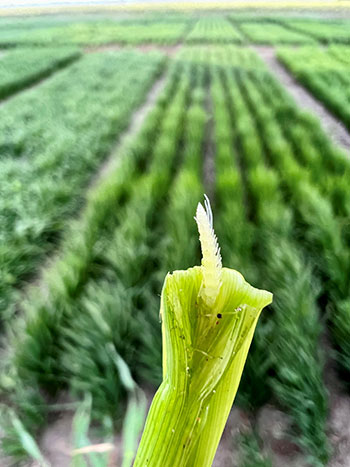A Grains Research and Development Corporation (GRDC) investment into late sown wheat and barley in the Albany and Esperance port zones is showing promise for growers impacted by autumn and winter waterlogging.
Trials sown in Munglinup, Needilup, Green Range and Condingup with times of sowing as late as September 29 this year are producing promising early results, according to researchers and agronomists who attended field walks this spring.
In one trial, Maximus barley seeded on August 24 at Munglinup was at booting growth stage just 55 days after sowing.
The trials are part of a GRDC investment led by Stirlings to Coast Farmers (SCF), in partnership with Fitzgerald Biosphere Group (FBG) and Southeast Premium Wheat Growers Association (SEPWA), and with trial providers Nutrien Ag Solutions and South East Agronomy Services, in response to waterlogging events in the Albany and Esperance zones in 2021 and 2022.
 Maximus barley at growth stage Z32 at the GRDC late sown cereals Condingup trial site, 47 days after seeding on August 24. Photo: Quenten Knight
Maximus barley at growth stage Z32 at the GRDC late sown cereals Condingup trial site, 47 days after seeding on August 24. Photo: Quenten Knight
In both seasons, large areas of crops remained unplanted well into August and September due to highly saturated soils making paddocks non-trafficable.
The Bureau of Meteorology reported that last month was the fifth-wettest October on record for WA, with the state’s October rainfall 133 per cent above average.
SCF Chief Executive Officer Lizzie von Perger said that challenging sowing conditions in the past two seasons had led to more questions than answers for growers.
“There were instances where crops were sown, suffered from waterlogging and subsequently failed and other instances where growers couldn’t get out in the paddock for sowing at all,” Ms von Perger said.
“With limited information on how well later sown crops perform, south coast growers didn’t know how late they could sow cereals after these failures and still be profitable.
“This project is an opportunity not only to respond to seasonal conditions, such as exceedingly wet years, but also to push the limits of production in the high rainfall zone.”
In the Esperance region, SEPWA Chief Executive Officer Michelle Handley said that a field walk at the project’s Condingup trial site during their Spring Field Day in September stimulated plenty of discussion on what growers could do in wet years.
“This type of year doesn’t happen all the time, but it does happen. There has been a lot of interest from growers because we don’t have the data around which varieties will perform in these conditions,” Ms Handley said.
“The really interesting thing is to see how ‘plastic’ these varieties are. Scepter, for example, is turning out to be a really flexible variety that is adaptable in a range of scenarios. Let’s see if late seeding is one of those scenarios.
“For this project we deliberately chose varieties that growers would have on hand, not ones that are specialised for late sowing. This is because growers are making in-season decisions on late sowing based on seasonal conditions, not at the start of the year.
“It’s about seeing if you can still do something profitable out of some really poor seeding conditions.”
GRDC Manager Agronomy, Sustainable Cropping Solutions – West, Dr Uys Lourens, said that the 12-month project was developed in response to feedback from GRDC National Grower Network (NGN) meetings.
“Given waterlogging is a relatively common occurrence in the Albany and Esperance port zones, it’s vital that growers have resources in order to mitigate losses and maximise productivity generated from late seeding,” Dr Lourens said.
“This project aims to fill this knowledge gap by providing locally relevant data for growers and consultants, including key growth stage timings, germination rates, and possible stress events resulting from a delayed time of sowing.”
Results and resources for growers in high rainfall areas of WA are anticipated to be available in April 2023.

























































